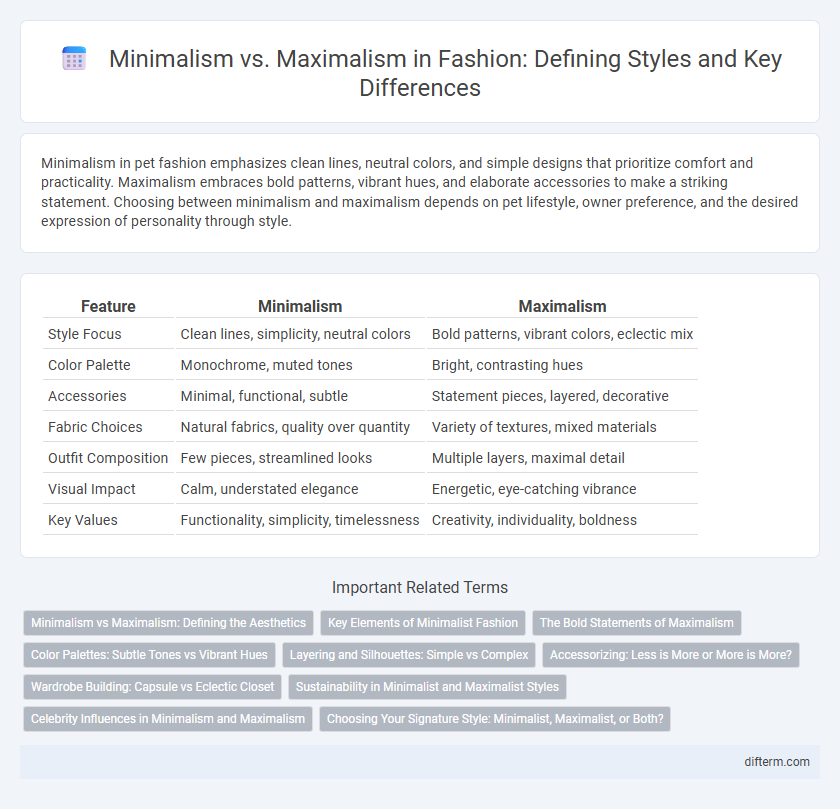Minimalism in pet fashion emphasizes clean lines, neutral colors, and simple designs that prioritize comfort and practicality. Maximalism embraces bold patterns, vibrant hues, and elaborate accessories to make a striking statement. Choosing between minimalism and maximalism depends on pet lifestyle, owner preference, and the desired expression of personality through style.
Table of Comparison
| Feature | Minimalism | Maximalism |
|---|---|---|
| Style Focus | Clean lines, simplicity, neutral colors | Bold patterns, vibrant colors, eclectic mix |
| Color Palette | Monochrome, muted tones | Bright, contrasting hues |
| Accessories | Minimal, functional, subtle | Statement pieces, layered, decorative |
| Fabric Choices | Natural fabrics, quality over quantity | Variety of textures, mixed materials |
| Outfit Composition | Few pieces, streamlined looks | Multiple layers, maximal detail |
| Visual Impact | Calm, understated elegance | Energetic, eye-catching vibrance |
| Key Values | Functionality, simplicity, timelessness | Creativity, individuality, boldness |
Minimalism vs Maximalism: Defining the Aesthetics
Minimalism in fashion emphasizes clean lines, neutral colors, and simplicity, often favoring timeless pieces that create a sleek, understated look. Maximalism, contrastingly, embraces bold patterns, vibrant hues, and layering, reflecting individuality and creativity through extravagant details. Both aesthetics offer distinct expressions: minimalism prioritizes subtle elegance while maximalism celebrates visual complexity and dynamic self-expression.
Key Elements of Minimalist Fashion
Minimalist fashion emphasizes clean lines, neutral color palettes, and high-quality fabrics to create timeless, versatile pieces that prioritize function and simplicity. Key elements include tailored silhouettes, monochromatic dressing, and the absence of excessive embellishments or patterns. This style promotes a refined wardrobe with essential staples that can be mixed and matched effortlessly.
The Bold Statements of Maximalism
Maximalism in fashion boldly challenges minimalist norms through vibrant patterns, eclectic textures, and layered accessories, creating visually striking ensembles that demand attention. Embracing rich colors, oversized silhouettes, and intricate details, maximalist style celebrates individuality and unapologetic self-expression. This approach transforms clothing into a dynamic art form, where bold statements redefine contemporary fashion boundaries.
Color Palettes: Subtle Tones vs Vibrant Hues
Minimalism in fashion emphasizes subtle tones such as muted pastels, soft greys, and earthy neutrals to create clean, understated aesthetics. Maximalism embraces vibrant hues like bold reds, electric blues, and bright yellows, crafting dynamic and eye-catching ensembles. The contrast between these color palettes defines the emotional and visual impact of each style, catering to distinct personal expressions and occasions.
Layering and Silhouettes: Simple vs Complex
Minimalism in fashion favors clean, streamlined silhouettes with subtle layering that emphasizes simplicity and function, often using neutral tones and monochromatic palettes. Maximalism embraces bold, intricate layering techniques and exaggerated silhouettes, combining vibrant colors, mixed textures, and diverse patterns to create visually complex outfits. These contrasting approaches highlight minimalism's focus on restraint and clarity versus maximalism's celebration of abundance and artistic expression.
Accessorizing: Less is More or More is More?
Accessorizing in minimalism emphasizes clean lines and subtle pieces that enhance an outfit without overwhelming it, focusing on quality over quantity to create a polished look. Maximalism embraces bold, layered accessories, mixing textures, colors, and statement pieces to express individuality and creativity. Choosing between less or more depends on personal style goals, with minimalism favoring simplicity and elegance while maximalism celebrates exuberance and complexity.
Wardrobe Building: Capsule vs Eclectic Closet
A minimalist wardrobe centers on capsule collections with a limited number of versatile pieces, promoting simplicity and ease in outfit coordination, while maximalism embraces an eclectic closet filled with diverse textures, patterns, and bold colors to express individuality. Capsule wardrobes enhance sustainability and reduce decision fatigue by focusing on quality essentials that mix and match effortlessly. Eclectic closets prioritize creativity and personal storytelling through layering and statement items, catering to those who seek variety and self-expression in daily fashion choices.
Sustainability in Minimalist and Maximalist Styles
Minimalist fashion emphasizes sustainability through timeless designs, reduced waste, and eco-friendly materials, promoting a capsule wardrobe that minimizes consumption. Maximalist style, while often seen as extravagant, can also adopt sustainable practices by prioritizing quality over quantity and using bold, durable pieces that last longer. Both styles contribute to sustainable fashion by challenging fast fashion norms and encouraging mindful purchasing decisions.
Celebrity Influences in Minimalism and Maximalism
Celebrity influences play a significant role in shaping minimalism and maximalism trends in fashion, with icons like Meghan Markle championing minimalism through sleek, understated looks and clean lines. In contrast, celebrities such as Rihanna popularize maximalism with bold patterns, vibrant colors, and extravagant accessories, driving global interest and consumer adoption. These contrasting styles, promoted by high-profile figures, significantly impact runway trends, brand strategies, and consumer preferences in the fashion industry.
Choosing Your Signature Style: Minimalist, Maximalist, or Both?
Choosing your signature style involves understanding the core principles of minimalism and maximalism in fashion. Minimalist style emphasizes clean lines, neutral tones, and versatile pieces that prioritize quality and functionality, while maximalism embraces bold patterns, vibrant colors, and layered accessories to express individuality and creativity. Combining elements from both styles allows for a personalized wardrobe that balances simplicity with statement-making details, catering to diverse occasions and moods.
minimalism vs maximalism (style) Infographic

 difterm.com
difterm.com